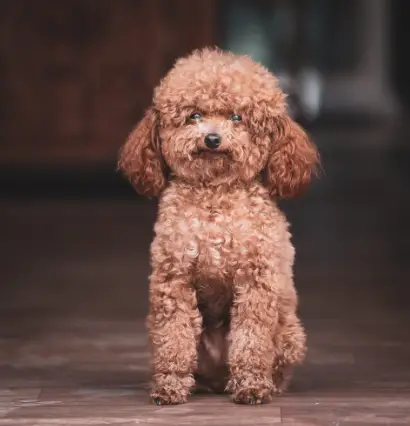Poodles are a popular dog breed known for their intelligence, hypoallergenic coat, and elegant appearance. However, many people are unaware that poodles come in a variety of sizes. In this article, we will explore the different sizes of poodles, including their characteristics, ideal living conditions, and grooming needs.
What are the Different Sizes of Poodle Dogs?
Poodles come in three different sizes: Standard, Miniature, and Toy. Each size has unique characteristics, and choosing the right size poodle for your lifestyle is essential.
- Standard Poodle
The Standard Poodle is the largest of the poodle sizes and can weigh between 45 and 70 pounds. They typically stand 15 inches or more at the shoulder. This breed is known for its regal appearance and impressive stature. Standard Poodles are active, intelligent, and have a playful personality. They are excellent family pets and get along well with children and other animals.
Standard Poodles require a lot of exercise and mental stimulation. They are not well-suited for apartment living, as they need plenty of room to run and play. They also need regular grooming to maintain their distinctive curly coat.
- Miniature Poodle
The Miniature Poodle is the middle size of the poodle breed, standing between 11 and 15 inches tall at the shoulder and weighing between 10 and 15 pounds. They are a great choice for those who want a poodle but do not have the space for a larger breed. Miniature Poodles are playful, intelligent, and affectionate.
Like the Standard Poodle, the Miniature Poodle requires regular exercise and mental stimulation. They are well-suited for apartment living but still need room to run and play. They also need regular grooming to maintain their curly coat.
- Toy Poodle
The Toy Poodle is the smallest of the poodle sizes, standing 10 inches or less at the shoulder and weighing between 4 and 6 pounds. They are a popular choice for those who want a lap dog or have limited space. Toy Poodles are intelligent, affectionate, and often have a feisty personality.
Toy Poodles are well-suited for apartment living and do not require as much exercise as their larger counterparts. However, they still need mental stimulation and playtime. Their small size means they are susceptible to cold weather, so they may need extra protection during the winter months. They also require regular grooming to maintain their curly coat.
What Are the Differences Between Standard, Miniature, and Toy Poodles?
While all poodles share some characteristics, each size has distinct differences in appearance, temperament, and needs.
Appearance: The most noticeable difference between the three sizes of poodles is their size. Standard Poodles are the largest, followed by Miniature Poodles, and Toy Poodles are the smallest. However, all poodles have the same curly coat, which requires regular grooming to prevent matting.
Temperament: While all poodles are intelligent, affectionate, and playful, each size has its own unique personality traits. Standard Poodles are known for their regal appearance and playful nature. Miniature Poodles are often more reserved and make excellent lap dogs. Toy Poodles can be feisty and have a lot of energy.
Living Conditions: The size of a poodle plays a significant role in determining the best living conditions. Standard Poodles need plenty of space to run and play and are not well-suited for apartment living. Miniature Poodles are better suited for apartments but still need room to play. Toy Poodles are well-suited for apartment living but may need extra protection in cold weather.
Grooming: All poodles require regular grooming to maintain their curly coat, but the amount of grooming needed depends on the size of
the poodle. Standard Poodles require the most grooming due to their larger size and denser coat. Miniature Poodles require less grooming than Standard Poodles, but still need regular brushing and trimming. Toy Poodles require the least amount of grooming, but still need regular brushing and haircuts to maintain their appearance.
Health: While all poodles are generally healthy breeds, each size has its own unique health concerns. Standard Poodles are susceptible to hip dysplasia, bloat, and eye problems. Miniature Poodles are prone to dental issues and luxating patellas. Toy Poodles can develop dental problems, liver shunts, and respiratory issues.
What are the Pros and Cons of Each Poodle Size?
Choosing the right size poodle for your lifestyle is important. Each size has its own set of pros and cons to consider.
Standard Poodle Pros:
- Great for families with children
- Active and playful
- Intelligent and trainable
- Elegant and regal appearance
Standard Poodle Cons:
- Needs a lot of exercise and mental stimulation
- Not well-suited for apartment living
- Requires a lot of grooming
- Can be prone to health issues
Miniature Poodle Pros:
- Great for apartment living
- Affectionate and lap dog
- Easy to train
- Requires less exercise than Standard Poodles
Miniature Poodle Cons:
- Can be reserved with strangers
- May have a higher risk of dental problems
- Still requires regular grooming
Toy Poodle Pros:
- Perfect for small living spaces
- Lively and affectionate
- Low exercise requirements
- Requires less grooming than other poodle sizes
Toy Poodle Cons:
- Can be prone to health issues due to their small size
- May not be ideal for families with young children
- Can be feisty and high energy
What Should You Consider Before Choosing a Poodle Size?
Before choosing a poodle size, there are several factors to consider, including:
- Living space: The size of your living space will play a significant role in determining which poodle size is right for you. If you live in a small apartment, a Toy or Miniature Poodle may be the best choice.
- Lifestyle: Your lifestyle will also determine which poodle size is best. If you have an active lifestyle and enjoy spending time outdoors, a Standard Poodle may be a good fit.
- Grooming: All poodles require regular grooming, but the amount needed varies by size. Consider how much time and effort you are willing to put into grooming your poodle before choosing a size.
- Health: While all poodles are generally healthy breeds, each size has its own unique health concerns. Consider any potential health issues before choosing a size.
Conclusion
In conclusion, poodles come in three different sizes: Standard, Miniature, and Toy. Each size has unique characteristics, including appearance, temperament, living conditions, grooming needs, and health concerns. Before choosing a poodle size, consider your living space, lifestyle, grooming preferences, and potential health issues. With careful consideration, you can choose the perfect poodle size to fit your lifestyle and bring years of joy and companionship to your home.







